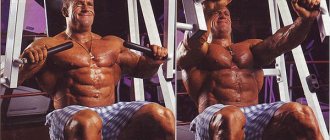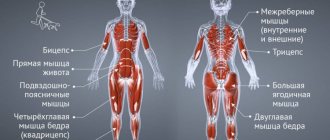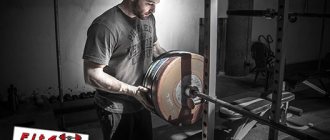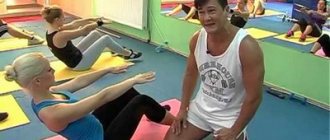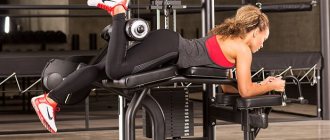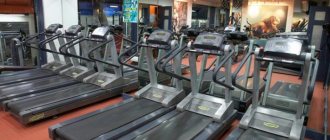Hello friends and girlfriends of the Fitkis blog!
I'm finally in the mood for the gym, I'm slowly getting back into shape, and the day will soon come when I'll be ready to launch the video format of my blog.
But it seems so recently that I came to the gym for the first time. Only since then a lot of water has passed under the bridge, life has acquired new colors and new priorities.
I recently talked about how I started training myself and what mistakes I made during my beginnings.
Today I will look at all the common mistakes that are typical for beginners in bodybuilding and fitness.
Let's get comfortable and let's go.
Beginners try all the exercise machines in a row
“Once in the gym, new members of sports clubs often start working out on all the machines they see in front of them, in a row. And they, being located nearby, often duplicate each other. In one room there may be, for example, six back exercise machines. It turns out that a person puts a load on the same muscle group. It is important for him (especially at the initial stage) to evenly distribute the load throughout the body. One machine for one muscle group is what a beginning athlete needs. And only a trainer can help you choose the right equipment.”
Mistake #4 – Pump up your abs every day
A typical mistake for beginners is when they work out their abs every day, sometimes several times a day, in the hope of getting the desired 6-pack abs. But you will never see abs as long as you have a layer of fat on top. Therefore, no matter how much you pump your abdominal muscles, without a low level of body fat, you can forget about sculpted and beautiful abs.
Beginners choose the wrong equipment for their needs
“In general, exercise machines are a fairly safe choice for a beginner in the sense that they eliminate the possibility of performing exercises globally incorrectly. Their design is such that the component parts move along a certain trajectory - and it cannot be changed. But here, too, there are undesirable actions: for example, out of ignorance, a person can begin his acquaintance with simulators for multi-joint exercises: these are loaded simulators, lever simulators that require traction movements. Few people understand how they work and move incorrectly, while control and stabilization are needed - on the part of the one who is doing it. Beginners often cannot provide this.
At first, you need to choose machines for single-joint exercises - for flexion and extension of the legs with a special roller, for shoulder abduction, and so on.”
Technique for performing the barbell curl
Error . This is typically seen when athletes attempt to lift weights heavier than their current physiological maximum. So they try to lift and finish the movement by rocking the body and creating additional momentum from the shoulders to make it easier for themselves to lift the bar to the end point.
When this happens, a lot of emphasis is placed on the lower back and shoulder joints, which are no longer the muscles that pull the weight. These muscles are responsible for the speed of movement.
The reason is that by using heavy weights you will further strain the muscles (muscle growth is the result of overload), however when the weight gets too heavy and this starts to happen, the biceps are no longer actually working, so there will be no positive results. .
Solution . To fix this problem, the first step is to reduce the amount of weight you lift. This is the main reason for the error. Let's look at the detailed technique.
Barbell curl
After this, really concentrate on keeping your elbows in a locked position at the sides of your body throughout the entire movement. This will help prevent the weight from swinging as if you were using a swinging motion, your elbows would also start to move upward. An alternative solution is to use dumbbells on an incline bench.
Alternating dumbbell raises on an incline bench
The best way to get results with this exercise is to use slow and controlled movements, so focus on resisting tension as you move in both directions. And then you will see much more changes in your hands than if you were performing oscillatory movements, as if performed incorrectly.
Beginners do not pay attention to body position
“Often during training with beginners, poor posture is observed (especially if the person leads a sedentary lifestyle or works in an office). They do not know how to hold their back - and this affects the quality of work with exercise equipment. For example, they sit down to do this or that movement and slouch, rounding their back. This is because her muscles are still weak. You need to start working with the correct position of your body on the simulator. These should be natural anatomical folds.”
Tips for Beginners
- Create a program for a week and work on it for at least two months.
- Three workouts a week is enough for a beginner.
- Each training day contains 6-8 exercises of 10-12 repetitions. Each exercise contains 2–3 warm-up approaches (30–70% of the working weight), two working approaches.
- Rest between sets - up to 90 seconds, rest between exercises - up to 120 seconds.
- Be sure to warm up.
- During training, move from large muscle groups to small ones.
- Learn and remember the technique for performing all the exercises included in the program.
- Breathe correctly.
- Progression in scales is required.
- Less talk - more action!
Beginners find basic exercises too simple
“And that’s why they’re doing them incorrectly. For example, when doing squats, a person tries to sit down as deeply as possible, believing that this is the key to effectiveness. Focusing on this, he makes mistakes: he “collapses” his knees inward due to the incorrect position of his feet. And you need your knees to “look” in the same direction as your socks. It is important to control the position of the knee joint and correctly distribute the load on the feet - safety when performing the exercise depends on this. Again, you need to hold your back, as is the case with exercise machines.”
Technique for performing the Army Press
Error . The bottom line is that athletes start out correctly by lifting the weight just above their head, but as they continue to lift the weight upward, they begin to swing their back, which causes a U-shaped curvature of the lumbar region. This creates an ideal situation for pain in the lower back. lower back. Let's consider the correct technique
Standing barbell press (military)
Before the exercise, thoroughly stretch your deltoid and core muscles. Highly warmed shoulder muscles and stretching will help avoid dislocations, sprains and fractures.
Beginners immediately choose the “impact” load
“Beginners have the sin of training and leaving all their strength in the gym. On the contrary, you need to join the training process very smoothly. Fatigue should be at the level of 50-60% on the scale of subjective sensations. It's a bit of a slog - but with the understanding that there's a little more that can be done. As a rule, 3-4 weeks are enough for a person to “get involved” and for his body to get used to the increasing loads.
At the same time, it is important to take into account your lifestyle and, in this context, not to forget about recovery. Anyone who goes to the gym three times a week and at the same time sleeps little and eats poorly is unlikely to adapt to exercise quickly.”
Common errors
ArturVerkhovetskiy/Depositphotos.com
11. Jogging on a treadmill as a warm-up. A good warm-up is the key to avoiding injury. Do it correctly, moving from the top of the body to the bottom.
12. Performing a new exercise with heavy weight. Start with light weights and gradually increase the load. This is much more effective in terms of muscle growth and will also help maintain proper technique.
13. Different number of approaches for different exercises. For each exercise, do 4-5 approaches, with 2-3 as warm-up sets and the rest as working sets. This is necessary so that your muscles adapt to the maximum load. To warm up, use a weight in the range of 30–70% of the working weight.
14. Frequent and intermittent breathing. Remember: each exercise has not only a technique of execution, but also a breathing technique.
15. Frequent changes in the training program. The program must be changed after at least two months. Only then will the training be effective.
16. Lack of progression in load. In each subsequent workout, the weight on the apparatus should be slightly more than the last time. For example: on Wednesday bench press with a weight of 50 kg for 10 repetitions, on the next Wednesday - 52.5 kg for 10 repetitions. If you can't complete the exercise 10 times, do as many as you can and switch to a new weight when you complete 10 repetitions. Thanks to constant weight gain, your muscles will grow, become more elastic, and a beautiful shape will not keep you waiting long.
17. Spending too much or too little time in the gym. The workout should last a maximum of 80–90 minutes, not counting cardio.
18. There are few basic exercises in the program. These exercises are called basic because they are considered the most effective for a particular muscle group.
19. Too many workouts per week. Professional athletes train often and a lot. For beginners, three workouts per week is enough.
20. Bad habits. Remember: alcohol and sports are incompatible things. If you have been drinking, forget about sports for at least two days. The heart is not iron. Alcohol kills protein synthesis.
21. Heavy weight on the bar. For muscle growth, it is not weight that is important, but the time the muscles are under load.
22. Unsystematic. Create a training program and stick to it. It is important to start training with large muscles and end with small ones.
Where to start then?
“A person who comes to a sports club must decide on his goal. What does he need for classes? If it is health, well-being, endurance, then he needs functional training. The gym is mainly for those who want to change their body composition - gain volume and muscle definition. At the same time, elements of functional training can also be obtained in a space with exercise equipment.
Here you need to undergo an introductory briefing with a trainer in order to gain an understanding of the basic principles of working on simulators, their functionality and to avoid mistakes. Next, you can begin low-intensity training, which provides a general load on all muscle groups. It is recommended to evaluate the intensity of exercise using a scale from 1 to 10, where 1 is no load at all, 10 is the maximum possible intensity (performing exercises to failure). At the initial stage, the intensity should be approximately 5-6 points. With each session you can add load, but it is extremely important to listen to your body and watch how it tolerates the load. If you are a beginner in the gym, it is better to “underload” than to “overload” your body. If your muscles don't hurt, it's okay. Pain and progress in the training process from a physiological point of view have nothing in common.”
Photo: unsplash-logoJesper Aggergaard
Mistakes when studying independently
ArturVerkhovetskiy/Depositphotos.com
6. Lack of a training program. She must be. It doesn’t matter where the program will be written: on a piece of paper, in a notepad or on the phone. However, the very fact of its existence does not guarantee the effectiveness of training.
7. Incorrect technique for performing the exercise. The correct technique means effective training, active growth of muscle mass and the absence of injuries in the future. Learn the correct technique for performing the exercise in advance.
8. Lack of insurance when working with heavy weight. Ask the trainer on duty to cover you. It is his direct responsibility to help people in the room. Many people are shy.
9. Performing an exercise with someone on the same machine. You are not required to share equipment or equipment with another person.
10. Embarrassment. Remember: the jocks in the gym also started somewhere.
You train with the same weights, violating the principle of load progression
Of course, it's easy to say: increase your training weights. What if they don't increase? Here you are, puffing and trying to squat instead of the usual 40, 50 kg, but you can’t, even if you crack the damn barbell. Moreover, sometimes a setback happens: come to the gym, and you’re not even given the “tamed” working weight for a long time! What to do?
Firstly, remember that in the hall there are not only pancakes of 15, 10 and 5 kg, but also small pancakes of 0.5, 1.25 and 2.5. They are not just scattered so that stern guys will trip over them.
Secondly, increase the weights gradually, without bypassing the intermediate ones: before you squat the cherished 50, you need to overcome 42.5, 45, and 47.5 . In addition, if you hope to do 8-12 repetitions at once, and even in 4-6 sets, then give up this stupid idea: it won’t work 100%.
Thirdly, strength still needs to be increased with single repetitions with near-maximum weights , slowly and gently, like growing beans for a biology lesson at school. Learn principle number 3 - you need to train in cycles. The most important thing is to learn to “jump” to a new cycle in time. Because sooner or later you will definitely get sick of the monotonously hard training. So you need to stop 1-2 weeks earlier so that the main thing is not depleted - enthusiasm . Otherwise, natural physical fatigue will become mental fatigue, and this is a fat cross for any style of training!
Mistake 5: bending to the sides with weights
Look
There is absolutely nothing wrong with this if you are a man. But it’s a rare girl who dreams of a wide waist. And this part of your body will inevitably become wider due to the development of the oblique abdominal muscles. So say goodbye to side bends once and for all, otherwise they will mercilessly ruin your life.
You train without a spark
Let’s say right away: of course, you don’t have to lift dumbbells with the happy smile of an idiot. But don’t forget, training is a psychologically stressful matter: it requires special concentration. Remember, a powerlifter gathers and tunes up internally before moving. At this moment everyone in the hall becomes quiet so as not to interfere or knock him down.
According to physiologists, mental concentration increases muscle strength by 10-12%, or even more . It is precisely for this reason that sport is alive: it is not muscles that compete, but characters, and this is always exciting! Such people are immediately noticeable: they are like metal that has been smelted and taken a certain shape.
If you constantly chat, sit on your phone, or walk around with a sullen expression during training, your brain builds new neural connections, and this behavior begins to become a habit. As a result, you yourself will develop stupid reflexes in yourself: when you come to the gym, you need to chat; I started doing squats and my mood deteriorated.
Of course, if you come to the gym after work, then your psyche is already tired and requires rest. And here's a new tension! I just want to chat or get upset. You can help yourself with this technique: do the exercises, especially the first ones, using the pyramid method . From set to set, reduce the number of repetitions while increasing the working weights. This helps the psyche gradually increase mental concentration.
Underestimation of the role of nutrition
Muscles, alas, do not grow out of thin air. Fat, alas, is not burned threefold with the wave of a magic wand. No matter how hard you work out in the gym, there will be no sustainable muscle growth or fat burning if your workouts are not supported by a nutritious, balanced diet . Nutrition stimulates muscle growth, ensures fat burning, accelerates recovery and is responsible for the secretion of hormones.
We have already discussed these problems in detail in the articles “17 reasons why weight stays the same” and “Sport is not a guarantee of weight loss .
